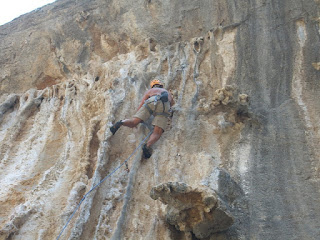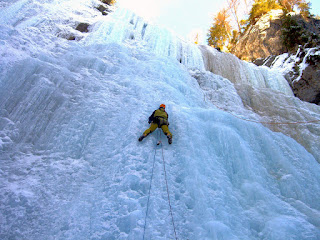Ice Tools
Black Diamond Carbon Fiber Cobras are fantastic alpine and pure ice tools. I wrap hockey friction tape around the shafts to give me extra grip while matching tools, hooking them on my shoulders, holding them in my mouth, gripping high, etc.
Picks on ice tools have to be correctly filed and sharp. I let course participants use my tools during courses and it's always a revelation to them how much easier it is to climb with properly tuned picks. Every surface and edge of a pick differently effects and influences how a tool enters and exits the ice.
On long alpine climbs or while soloing, I use the Black Diamond elastic sling with mini-carabiners to attach the tools to my harness. On pure ice climbs I usually just go leashless. I haven't used leashes in years, and hate climbing with them.
Crampons
This is one area where I am still not completely satisfied with my boot and crampon system. I am currently using the La Sportiva Nepal Extreme Evo GTX. This boot fits my foot well and is a great all around alpine boot. However it is sort of "clunky" feeling and heavy. It is also a bit outdated from boot design and technology. I would like to change to boot that is lighter, more nimble to climb with and a bit warmer, especially in the toe area. I will be looking at the new La Sportiva Batura Evo GTX , the La Sportiva Trango Extreme Evo and the Scarpa Phantom Guide.
For early season ice and mixed-type conditions, I have been using mono-points. I have Grivel G-14's with their "crampo-matic" system (plastic cage holding toe and step-in lever at the heel). For pure ice, I have been using the last generation Grivel Rambos.
The G-14 attachment system has benefits in alpine situations, but on pure ice climbs I want a more solid feeling of connection on the toe of my boot. Another minor grip with the system is that it places the front points just a bit too far under the toe of the boot. The Rambos have a vertical frame that lifts your foot higher over the ice and this feels unnatural at times.
I want to change to a crampon with a wire bail toe system in the front that is low profile. Something like the Black Diamond Cyborg Pro looks interesting. I am almost ready to completely change to just using mono-points.
The G-14 attachment system has benefits in alpine situations, but on pure ice climbs I want a more solid feeling of connection on the toe of my boot. Another minor grip with the system is that it places the front points just a bit too far under the toe of the boot. The Rambos have a vertical frame that lifts your foot higher over the ice and this feels unnatural at times.
I want to change to a crampon with a wire bail toe system in the front that is low profile. Something like the Black Diamond Cyborg Pro looks interesting. I am almost ready to completely change to just using mono-points.
Protection
Black Diamond New Turbo Express Screws - the screws bite very well, so setting them is quick and easy. The double hole in the hangers allow you to set up anchors and belay without slings.
I'll take 12 to 14 screws on most pure ice climbs without fixed belays. The majority are 16cm and 19cm. I always have at least one 22cm screw and at least two 13cm screws.
I have built up my own quickdraws using two very light, yet large, Wild Country carabiners. The lower 'biner is a silver bent gate and the upper one is a gold straight gate. They do not freeze up and are easy to handle with gloved hands. I join the two carabiners with Petzl 11cm slings, fixing the lower 'biner with a rubber sleeve that keeps it in place and eases clipping.
I always have two quick draws rigged with shock absorbing slings (Petzl, with reusable Velcro closure). I'll use these whenever an ice screw placement is marginal, or as the first screw right off the belay. My only lead fall on ice was on a 16cm screw with a Yates screamer. The screw held the five meter or so fall. The screamer completely ripped. I was uninjured.
Ropes
If I know that the descent is a walk-off, then I use a light 70m single rope. I have been using a 9.2 Nano from Sterling Ropes. So far I have been impressed with its handling and durability.
When I climb multi-pitch ice privately with a partner, and it's a rappel descent, I like to carry a single strand (ca.7.1) of a 70m twin rope to use on rap. The rope is carried in one of the climbers packs and used just on the descent.
I know that using a single rope leading an ice climb is amount to blasphemy, but there is really no sharp edge danger on ice when leading, the second needs to be belayed tight (you do want to go as fast as possible, don't you?) so there should be no problem with the second hitting the rope with an errant swing. The benefit of a single rope is the incredible gain in speed and simplicity in the whole system.
If I need a double rope system for guiding two seconds, or because the type of climbing dictates it, then Beal Ice Lines with Golden Dry treatment are the best half-ropes around. I used Mammut Phoenix half ropes last season because I got them for a very good price. Their handling was okay, but they seemed to twist easily. Water proofing was good, however they were not at all durable.
Miscellaneous
I never fix myself to the belay with a sling as the team climbs. I always use the rope clove hitched to a locking carabiner. You can adjust the length of the rope to position yourself comfortably away from falling ice released by the leader or inside a small cave or flat stance. Additionally, the rope is obviously dynamic, so in case of an unexpected slip, you won't statically shock load the anchor.
I use a Petzl Reverso 3 as my belay device. It is absolutely essential that you belay the second with a self-locking device. Doing so gives the leader time to drink, eat, put on a belay parka, organize the belay, etc., while the second climbs. Additionally it guarantees that the second will not fall down the length of the rope should heavy spindrift or an avalanche wash down over the belay causing the leader to lose control of the rope. The Reverso 3 is light and has design features that I feel make it the best device of its kind.
I have a total of four locking carabiners with me. They are all different shapes, sizes and colours. One is my self-belay 'biner that I tie into, one is used to clove hitch the rope to the back up screw at the belay. The other two are for the Petzl Reverso when bringing up the second. It is much easier to keep track of everything at the belay when the locking carabiners are all different.
I always have my "ice drill"/"rescue kit" on one of my back harness loops: a 22cm screw, V-thread hook, 7mm cord and a Petzl Ti Block I carry a small knife in one of my jacket pockets in case I have to cut the cord.
I usually have one 120cm and one 60cm sewn slings with me for threading around icicles or small trees, to use as a self-belay sling on rappel, or to use in rescue applications. I also stick either a very short sewn sling or a short 5mm Prusik in a pocket to tie-off screws or use as a rappel-brake back up.
I climb with a very small, low-profile, light back pack. Inside are a belay parka, belay gloves, extra climbing gloves, a small head lamp, very small first-aid kit (really just tape & butterfly bandages) and a half-liter warm drink.
I climb with a very small, low-profile, light back pack. Inside are a belay parka, belay gloves, extra climbing gloves, a small head lamp, very small first-aid kit (really just tape & butterfly bandages) and a half-liter warm drink.




























